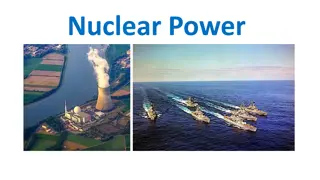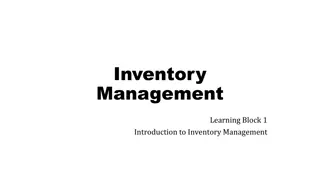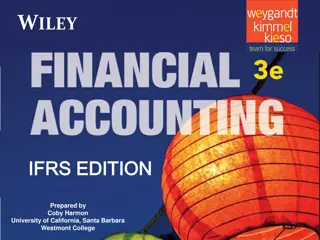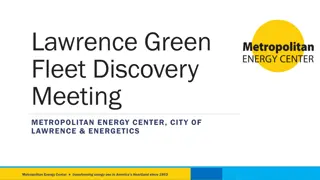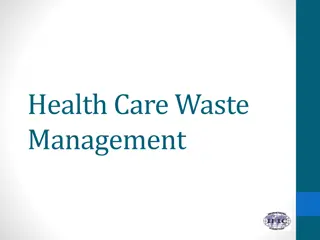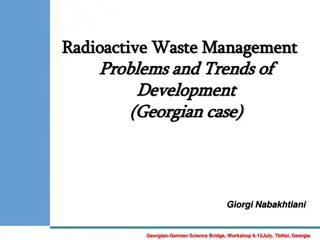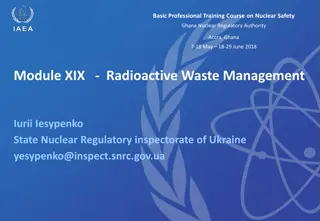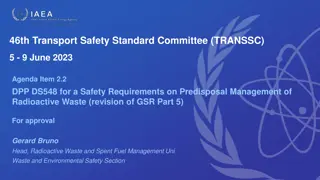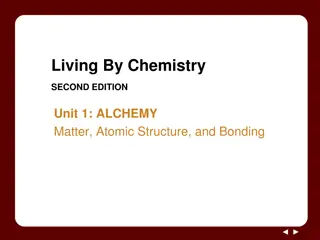Prospective Inventory of Radioactive Materials and Waste Management Study in French Nuclear Fleet
The study conducted by the French Atomic Energy Commission in collaboration with industrial partners like EDF, Orano, and Framatome explores different plutonium recycling options in the French nuclear fleet. It assesses scenarios involving open cycle, mono-recycling, and multiple recycling of plutonium and uranium in various reactor types. The study aims to comply with the French law on radioactive waste management and has implications for the sustainable future of nuclear energy in France. Advanced fuel technologies are also considered to stabilize plutonium inventories and spent fuel stockpiles. The transition to fast reactors is discussed, highlighting the challenges and objectives of each phase.
Download Presentation

Please find below an Image/Link to download the presentation.
The content on the website is provided AS IS for your information and personal use only. It may not be sold, licensed, or shared on other websites without obtaining consent from the author. Download presentation by click this link. If you encounter any issues during the download, it is possible that the publisher has removed the file from their server.
E N D
Presentation Transcript
Prospective inventory of radioactive materials and waste produced by the French nuclear fleet according to different plutonium multiple recycling options in the frame of the French law for waste management AIEA Conference Vienna June, 26th 2019 C. Chabert , E. Touron, A. Saturnin, F. Courtin, G. Krivtchik, Ph. Miranda, G. Martin, JL. Girotto with the collaboration of French industrial partners EDF, ORANO, FRAMATOME Atomic Energy and Alternative Energies Commission - www.cea.fr June, 26th2019 Commissariat l nergie atomique et aux nergies alternatives
CONTEXT In accordance with the French Act of 28 June 2006 on the sustainable management of radioactive materials and waste, the CEA in partnership with EDF, Orano and Framatome, has studied prospective scenarios using different fuel cycle options: o Open cycle, o Mono-recycling of plutonium and uranium in PWRs (current option for the French nuclear power fleet), o Multiple recycling of reusable materials in SFRs o Multiple recycling of plutonium in PWRs The results of this study has been submitted by the CEA to the Ministry of Energy within the scope of Article 51 of the Ministerial Order dated 23 February on the French National Radioactive Materials and Waste Management Plan (PNGMDR). June, 26th2019 2 Commissariat l nergie atomique et aux nergies alternatives
FUEL CYCLE TRANSITION SCENARIOS Progressive implementation of SFRs through successive phases: Each phase envolves the more significant deployment of fast reactors with its own growth objective Phase 0: hypothetical French fleet having in an open cycle configuration only June, 26th2019 3 Commissariat l nergie atomique et aux nergies alternatives
FUEL CYCLE TRANSITION SCENARIOS However, SFRs may not become economically competitive in the next few decades as uranium resources would remain readily available Advanced fuel technologies, called CORAIL-2000 and MIX, are applied to enable multiple recycling of plutonium in standard PWRs The main objectives of these scenarios consist in stabilizing the plutonium inventory as well as all spent fuel stockpiles June, 26th2019 4 Commissariat l nergie atomique et aux nergies alternatives
MULTI-RECYCLING CONCEPTS IN PWRS CORAIL and MIX concepts studied in CEA near 2000 MIX assembly - Homogeneous concept - 1 type of rods within assemblies - MOX rods with a support of enriched uranium to compensate for the degradation of the Pu isotopy - Constant Pu content, 3 cases in our study (8%, 9,54%,12%) - Pu consumption -43kg/TWhe (MIX 9,54%) CORAIL assembly design with 84 MOX rods - Heterogeneous concept - 2 types of rods within assemblies: UOX and MOX - U235 fixed (~5%) and Pu ajusted to compensate the Pu isotopic degradation (<12%) - Pu consumption 0kg/TWhe June, 26th2019 5 Commissariat l nergie atomique et aux nergies alternatives
ASSUMPTIONS Few assumptions o The nuclear energy production remains steady at its current level, about 420TWhe/y o The starting point is the actual situation (with 58 PWR) o A lifespan of 60 years for future reactors (PWR and FR) o A lifespan of 50 years for the fuel cycle plants (La Hague/Melox facilities renewal near 2040) o For the FR fleet, the CFV core concept (low sodium void effect) (CEA) is considered (600MWe, 1GWe and 1,45GWe) For scenarios involving the progressive deployment of SFRs: o Start-up of commercial SFRs: 25 years after the industrial commissioning of the demonstrator (assumed in this study to be in 2039), i.e. in the mid-2060s o This timescale takes into account the need for sufficient feedback from the operation of the demonstrator and for realistic lead times for technical and regulatory actions For scenarios involving the multiple recycling of Pu in PWRs: o The industrial deployment of CORAILand MIX concepts would be theoretically possible in 2045 o Atimescale that seems at this stage in the studies to be reasonable, allowing qualification of these new fuel products. June, 26th2019 6 Commissariat l nergie atomique et aux nergies alternatives
FR DEPLOYMENT MAIN CHARACTERISTICS FOR EACH PHASES A B C D2 D1 Open cycle (0) 0 Fraction of SFRs in the fleet Unat consumption (t/year) Pu inventory 0% 4.5% 31% 73% 100% 6000 5700 3400 0 0 7500 7.2 6.8 Stabilised Stabilised Stabilised 9.9 (t/year) Minor actinide inventory (t/year) Increase in the spent fuel inventory (t/y) 3.3 3.1 4.4 3.4 2.3 2.7 180 130 0 0 0 950 The transition from phase A to phase D improves - at each phase - the quantities which are characteristic of the sustainable management of materials Each phase makes its possible to improve the industrial maturity of the fast reactors whose integration into phase B remains very minor (4,5% of the fleet) June, 26th2019 7 Commissariat l nergie atomique et aux nergies alternatives
MULTIPLE RECYCLING OF PU IN PWRS MAIN CHARACTERISTICS FOR EACH PHASES Multi-recycling of Pu in PWRs can lead to additional savings in uranium resources up to about 10% compared with the current once-through recycling in a configuration where reprocessed uranium is recycled (for a total exceeding 25% compared with an open fuel cycle) MIX/ CORAIL concepts enable to recycle all spent fuel and stabilize Pu inventory June, 26th2019 8 Commissariat l nergie atomique et aux nergies alternatives
FUEL CYCLE TRANSITION SCENARIOS SCENARIOS INVOLVING THE PROGRESSIVE DEPLOYMENT OF SFRS Scenario ABCD1 involves the successive deployment of all phases, starting with phase A (once-through recycling of Pu in PWRs), then phase B (stabilisation of spent PWR MOX by recycling in a few SFRs), followed by phase C (stabilisation of the Pu inventory using a symbiotic PWR-SFR fleet), and finally phase D1 (100% SFR fleet) o Scenario ABCD2 ends with a hybrid fleet comprising SFRs and 100% MOX PWRs o Scenario ABD2 : an alternative to scenario ABCD2 where deployment of D2 is accelerated (this scenario could apply in the case where the price of natural uranium rises rapidly or there is a shortage of natural uranium). o June, 26th2019 9 Commissariat l nergie atomique et aux nergies alternatives
SCENARIOS INVOLVING THE PROGRESSIVE DEPLOYMENT OF SFRS - MAIN RESULTS 2000 Consommation d'uranium naturel (kt) 1800 2400 Open cycle Open cycle Once-recycling 2200 1600 2000 1400 Once-recycling Inventaire en plutonium (t) 1800 1200 1600 1000 1400 800 Multi-recycling 1200 600 Multi-recycling 1000 400 800 200 600 0 400 2015 2045 2075 2105 2135 2165 2195 200 2015 2045 2075 2105 2135 2165 2195 A ABCD1 ABCD2 ABD2 Cycle ouvert Cycle Ouvert (0) Pu inventory stabilized A ABCD1 ABCD2 ABD2 Unat consumption decreased until 0 80 Open cycle Inventaire de combustibles us s (kt) 70 Once-recycling Open cycle Once-recycling ABCD1 ABCD2 ABD2 60 A 50 ABCD1 40 ABCD2 Multi-recycling 30 ABD2 Cycle ouvert 20 10 0 2015 Phase C: spent fuel inventory stabilized 2045 2075 2105 2135 2165 2195 June, 26th2019 10 Commissariat l nergie atomique et aux nergies alternatives
SCENARIOS INVOLVING THE MULTIPLE RECYCLING OF PU IN PWRS Scenarios implementing MIX/CORAIL concepts Example: concept MIX 9,54% Pu associated with ERU EPR June, 26th2019 11 Commissariat l nergie atomique et aux nergies alternatives
NATURAL URANIUM CONSUMPTION 1800 Consommation d'uranium naturel (kt) 1600 1400 1200 1000 800 600 400 200 0 2015 2045 2075 2105 2135 2165 2195 A ABCD1 ABD2 MIX 9,54% MIX 9,54% avec URE CORAIL Self-sufficiency with respect to natural uranium can only be achieved by opting for the closed fuel cycle, i.e. deployment of SFRs Compared with scenario A, the consumption of natural uranium in the MIX/CORAIL scenarios without ERU management is always higher by about 10 to 15% depending on the Pu content In a configuration where reprocessed U is recycled, the multiple recycling of Pu in PWRs can lead to additional savings in U resources June, 26th2019 12 Commissariat l nergie atomique et aux nergies alternatives
STABILIZATION OF SPENT FUELS AND OF THE PLUTONIUM INVENTORY Stabilization of the total SF quantity near 2060 Stabilization of the Pu inventory achieved from ~ 2060 in all presented scenarios But the Pu multi-recycling in PWRs increases the production of minor actinides up to 4.2 - 4.5 t/year (vs. 3.3 t/year for step A": increase ~ 30%) June, 26th2019 13 Commissariat l nergie atomique et aux nergies alternatives
WASTE AND GEOLOGICAL DISPOSAL The waste disposal surface area required for the different options has been assessed in terms of the thermo-hydro mechanical (THM) and thermal design criteria relying on data provided by Andra, corresponding to current hypothesis of CIGEO project This study does not pre-empt the location of the disposal site for the waste considered, nor any evolution or optimisations of the disposal design For this study: clayey rock similar to the layer of argillaceous rock studied in the Meuse/ Haute-Marne region for the Cig o project Surface area required for HLW for a period of 60 years and after an interim storage periode of 80 years SPENT FUEL: Annual thermal power (kW/y) to be stored (after interim storage during 80 y) 600 500 400 300 200 100 0 A large quantity of spent fuel emitting high thermal releases in phases 0, A and B will also require disposal and thus a large disposal surface area June, 26th2019 14 Commissariat l nergie atomique et aux nergies alternatives
MAIN CONCLUSIONS CEA in collaboration with EDF, Framatome and Orano has studied the industrial feasibility of scenarios involving the progressive deployment of multiple recycling of Pu in French sodium fast reactors and also in PWRs A deployment of about 4,5% of SFR (~3 GWe) in the French fleet would be sufficient to stabilise the interim storage of spent PWR MOX fuel (Phase B) It is possible to stabilise the Pu inventory by deploying a symbiotic PWR-SFR fleet with about 30% of SFR in the fleet (Phase C) A full deployment of SFR or a mixed fleet comprising 75% breeder FRs and 25% PWR fuelled with 100% MOX allows our independance on natural uranium resources (Phase D) This independance could be reached about 60 years earlier with a faster deployment of SFR ( Scenario ABD compared ABCD) June, 26th2019 15 Commissariat l nergie atomique et aux nergies alternatives
MAIN CONCLUSIONS Recycling of Pu with MIX and CORAIL fuel assemblies in PWRs by the middle of the century could lead to a stabilization of spent fuel and plutonium inventories Small savings on U resource consumption may be reached only when considering the recycling of reprocessed U into ERU fuels Industrial feasibility is under evaluation (requires adaptations of the fuel cycle plants or even new facilities according to design and fuel capacity manufacturing and treatment) Waste disposal footprint: - only the disposal surface area required for vitrified waste packages has been estimated, considering current hypothesis of the French disposal project - These studies are still ongoing in collaboration with Andra to estimate the surface area required to dispose of the non-recycled spent fuels June, 26th2019 16 Commissariat l nergie atomique et aux nergies alternatives







